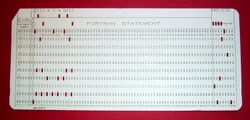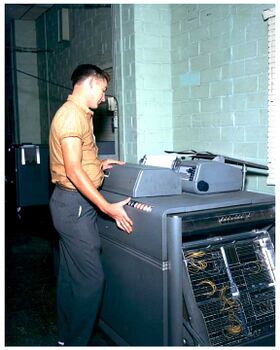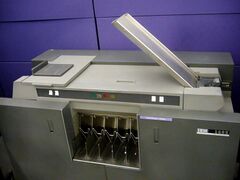Computer operator
A computer operator is a role in IT which oversees the running of computer systems, ensuring that the machines, and computers are running properly.[1] The job of a computer operator as defined by the United States Bureau of Labor Statistics is to "monitor and control ... and respond to ... enter commands ... set controls on computer and peripheral devices. This Excludes Data Entry."[2]
Overview
The position has evolved from its beginnings in the punched card era. A Bureau of Labor Statistics report published in 2018 showed that, in the public sector, a major employer of those categorized as Computer Operator was United States Postal Service. In the private sector, companies involved in data processing, hosting, or related services employed computer operators at an even higher rate. The states with the highest employment for computer operators, as of 2018, are: New York, Texas , California , New Jersey, and Florida.[1]
Job role description
The former role of a computer operator was to work with mainframe computers which required a great deal of management day-to-day including manually running batch jobs; however, now they often work with a variety of different systems and applications. The computer operator normally works in a server room or a data center, but can also work remotely so that they can operate systems across multiple sites. Most of their duties are taught on the job,[citation needed] as their job description will vary according to the systems they help to manage.
Responsibilities of a computer operator may include:
- Monitor and control electronic computer and peripheral electronic data processing equipment to process business, scientific, engineering, and other data according to operating instructions.
- Monitor and respond to operating and error messages.
- May enter commands at a computer terminal and set controls on computer and peripheral devices.
- Excludes "Computer Occupations" (15-1100) and "Data Entry Keyers" (43-9021).
The role also includes maintaining records and logging events, listing each backup that is run, each machine malfunction and program abnormal termination. Operators assist system administrators and programmers in testing and debugging of new systems and programs prior to their becoming production environments.
Modern-day computing has led to a greater proliferation of personal computers, with a rapid change from older mainframe systems to newer self-managing systems. This is reflected in the operator's role. Tasks may include managing the backup systems, cycling tapes or other media, filling and maintaining printers. Overall the operator fills in as a lower level system administrator or operations analyst. Most operations departments work 24x7.
A computer operator also has knowledge of disaster recovery and business continuity procedures. Formerly, this would have meant sending physical data tapes offsite, but now the data is more than likely transmitted over computer networks.
Specializations
Console operator
A console operator interacts with a front panel or a multi-user system's console
- entering system commands via a keyboard[lower-alpha 1]
- entering commands for a subsystem, e.g., HASP, via a keyboard[lower-alpha 1]
- replying to requests for informationTemplate:EFN
- taking actions such as mounting computer tapes that were "pulled" by a tape librarian
- supervising a tape operator, especially when there is a non-specific mount request.Template:EFN
These individuals would be trained to use specialized equipment related to their duties.
Beyond the IBM System/360 era
One example of specific hardware used by a console operator is the IBM 3066 Model 2 system console, which included a light pen[citation needed] as an interface device. Other then-new features were:
- replaced "most switch, pushbutton, and indicator functions"Template:EFN
- as with the 165's Model 1, had a microfiche document viewer, a feature introduced for the 360/85's console.Template:EFN
A console printer (up to 85 characters per second) to provide hard copy was optional when the console was in display mode, and required when it was in printer-keyboard mode.[citation needed]
Peripherals operator
A peripherals operator uses dedicated peripheral equipment connected to computer(s) such as printers, scanners, or storage devices for data transfer to and/or from computers.[3]
Tape operator
Historically, tape operators were in charge of swapping out reels of paper tape, reels of magnetic tape or magnetic tape cartridges that stored computer data or instructions.
Card reader operator
Depending on the type of card reader, either the "9-edge" or the "12-edge" was towards the card reader operator inserting the cards - but the deck of cards was always placed face down.
The United States Army's wordings were:
- Load cards in hopper face down, 12 edge out, column 1 to the left (1977)[4]
- Place cards in hopper face down with 12 edge to operator (1981)[5]
- 12 edge / face down : IBM orientation.
- nine-edge (also face down) : some other card readers.
Printer operator
In addition to filing or delivering computer printouts,[6] a printer operator at times loads standard or, as directed by a console operator or a remote console, specialized forms.
Tab operator
</ref>[7]}}
The tab operator (short for tabulating) would be responsible for preparing and operating tabulating machines to produce statistical results.[8] Hardware such as the IBM 08x sorter series[citation needed] were called tabulating equipment. The 1980 census specifically counted Tab operators ("Tabulating-machine operator").[9]
Tape librarian
A tape librarian is responsible for the management, storage, and reporting involving data storage tapes. The tape librarian would develop and/or maintain an organization system for the storage and retrieval of tapes,[10] and assist in disaster recovery. Additionally, the librarian would ensure the integrity of the tapes, and submit recommendations for replacement when needed.[11] Some examples of equipment a tape librarian may work with are the IBM 3850.
Gallery
Modern System operator consoles no longer include large numbers of lights, switches, or buttons
The 370/158 announcement said that "the console used a CRT display, a keyboard, and a light pen."
IBM 1402 high speed card reader and punch used in larger installations and typically run by an operator
See also
Notes
References
- ↑ 1.0 1.1 "Computer Operators". Bureau of Labor Statistics. https://www.bls.gov/oes/current/oes439011.htm.
- ↑ "Occupational Employment and Wages, May 2018: 43-9011 Computer Operators". Bureau of Labor Statistics. https://www.bls.gov/oes/current/oes439011.htm.
- ↑ "Work Processes Schedule". https://usmap.netc.navy.mil/usmapss/static/wps/wps.jsp?aimsParm=0817N.
- ↑ Soldier's manual: digital subscriber terminal equipment repairman, MOS 34F, skill levels two and three. Department of Defense, Department of the Army, Headquarters. 1977. https://books.google.com/books?id=9UWiqYseJ4sC.
- ↑ MOS 72E: combat telecommunications center operator. 1981. https://books.google.com/books?id=vzEmWzvRbbQC.
- ↑ V Chachra (1982). "Computing in Higher Education: A Planning Perspective". https://files.eric.ed.gov/fulltext/ED236974.pdf.
- ↑ Gary Regan (2003). The Joy of Mixology. p. 67. ISBN 0609608843. https://books.google.com/books?isbn=0609608843. "When people run a tab (ask to pay at the end of the evening rather than ..."
- ↑ Morgan, Richard. "TABULATING MACHINE OPERATOR (400)" (in en-gb). https://militaryyearbookproject.com/references/old-mos-codes/wwii-era/army-wwii-codes/administration/1435-tabulating-machine-operator-400.
- ↑ 1980 Census of Population: Classified Index of Industries. United States. Bureau of the Census. 1980. https://books.google.com/books?id=wNxpTUGEWFgC.
- ↑ "Information Systems". https://mis.umsl.edu/files/pdfs/ITCareers.pdf. "The tape librarian records the location of all tapes that are created"
- ↑ "Tape Librarian". http://www.westchestergov.com/hr/jobspecs/cjs/county/T/TAPELIBRARIAN.pdf.
 |











